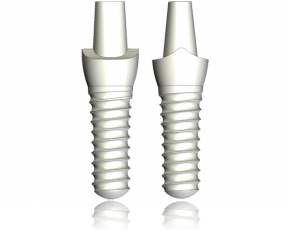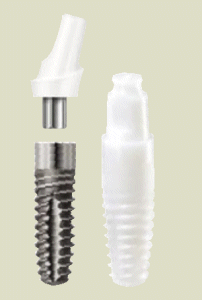When you hear the word “dental implantsâ€, an image of a metal screw automatically comes to mind but did you know that there are few types of dental implants? Dental implants are constructed from a range of materials such as titanium, stainless steel, titanium alloy and zirconium oxide ceramics.
Ceramic tooth implants, specifically known as zirconium or zirconia dental implants, are one of the newer forms of dental implants. Tooth-colored, compatible with our tissues, and made of the hardest stuff next to diamonds, it is of no surprise to hear that all ceramic dental implants are making their way to the U.S. after establishing themselves in the European market.
What are zirconium/zirconia/ceramic dental implants?
Zirconium oxide ceramics are used to manufacture materials that work in aggressive environments, like extrusion dyes, valves and port liners for combustion engines. Zirconium oxide implants have outstanding mechanical properties, good stability, a high biocompatibility and a high resistance to scratching and corrosion.
Zirconium oxide is ivory in color making it similar to the color of the natural tooth, which is important for restoring teeth in the mouth especially in the front teeth. Furthermore its ability to transmit light makes zirconia a suitable material in fillings that require aesthetics.
What are the advantages of ceramic dental implants?
- Since the middle of the 1980s, zirconium oxide has a firm place among high performance ceramics and has already been used for more than 20 years for hip joint replacement implants.
- Dental ceramic implants are bio-compatible (completely tissue-friendly); there are no allergic reactions, no sensitivity to temperature and no impact on taste. The zirconium oxide ceramic shows no interactions with other dental materials and is electrically neutral.
- Because of a friendly gum reaction and due to dental plaque being less attached to them, the crown margin shows no symptoms of inflammation in the gums region. Better gum health minimizes the risk of losing an implant.
- Since zirconium is white and is much more similar to natural teeth, the aesthetics is more easily achieved than regular titanium implants. Even if soft tissue around the tooth recede, which is possible over time, ceramic dental implants will not reveal ugly gray lines like in the case of titanium implants.
- Some patients dislike the idea of having metal in their mouths and some allergies to titanium have been reported therefore ceramic dental root implants could be their preferred choice.
Are there any problems with ceramic dental implants?
- Zirconium dental implants are a one piece structure and you will need to see your dentist quite a few times over a period of 4 – 6 months for monitoring of the healing. Also, a one-piece implant can only work in one position, unlike a two-piece implant for which angled abutments are available.
- Zirconia implants may be subjected to hydrolysis whereby they can absorb water and become prone to fracture.
Ceramic dental implants vs titanium dental implants
- Titanium is regarded as the ‘gold standard’ for dental implant materials. Numerous studies have affirmed the high success and survival rates of titanium implants in many different applications. One disadvantage is that it can result in poor aesthetics, especially in front of in the mouth, because of its grayish color, exposure of the implant body due to soft tissue recession or if the individual has thin gums.
- Titanium and zirconium are the only two elements that don’t block implants from integrating into bone. In regards to integration with the bone, zirconium implants appear to offer the same success rates as titanium implants. Some dental professionals may view them as less stable and liable to fracture than the standard titanium implant.
- Zirconium implants have an obvious aesthetic advantage over titanium implants being ‘pure white’, making them indistinguishable from natural teeth. Titanium and other types of implants are usually silver-black in color and can sometimes be viewed through the gums. However, the all white zirconium implant blends in naturally with the other teeth.
Where can I get ceramic dental implants?
Two companies, Oral Iceberg and Nobel Biocare, have developed all-zirconia implants, but have yet to market them in the U.S. Commercial zirconia implant systems currently available are the following:
- CeraRoot (Oral Iceberg, Barcelona, Spain)
- Sigma (Incermed, Lausanne, Switzerland)
- White Sky (Bredent Medical, Senden, Germany)
- Z-systems (Z-systems, Konstanz, Germany)
- Zit-z (Ziterion, Uffenheim, Germany)
How much will ceramic dental implants cost?
Since all ceramic dental implants are not widely available in the U.S. market yet it is difficult to quote the price but they should range around the same price of titanium dental implants of around $1500 to $5000. However you may be able to get cheaper ceramic dental implants overseas especially in European countries which have long established themselves with ceramic implants systems.




Pingback: Permanent Dentures Cost in the US and Malaysia | Intelligent Dental
Ceramic implants are much more bio friendly than metal, which can slowly corrode over time and weaken.
Genial brief and this enter helped me alot in my college assignement. Thank you as your information.
regarding the problems listed above about zirconia implants, these statements are somewhat inaccurate. First, there are systems available, where the abutement can be prepared and as a result, these implants can be used in any tooth indication in the mouth. Hydrolysis is all dependent upon the manufacturing process. If a zirconia implant is put through the HIP process then hydrolysis is not an issue to be concerned with. It’s important to do your research about the different systems in order to get these answers.
@jim
Thank you for your reply. I have to admit that I am not well-versed with all the available systems in the market but I will try to better myself next time.
Pingback: dental implants cost